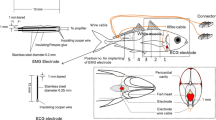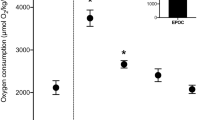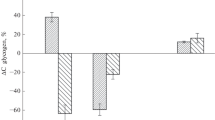Summary
Pagothenia borchgrevinki, an Antarctic teleost fish was swum to exhaustion and changes in lactic acid levels and blood haematocrit were monitored during recovery. The fish did not perform well at high swimming speeds due to an inability of the white myotomal muscle to produce ATP by anaerobic glycolysis. Consequently, low levels of lactic acid were produced which were fairly rapidly broken down. Haematocrit values were low in non-exercised fish, and these increased by over 100% during exercise, falling back to control levels over many hours. This is probably related to the increased oxygen demand during exercise.
Similar content being viewed by others
References
Beamish FWH (1968) Glycogen and lactic acid concentrations in Atlantic cod (Gadus morhua) in relation to exercise. J Fish Res Board Can 25:837–851
Blake RW (1983) Median and paired fin propulsion. In: Webb PW, Weihs D (eds) Fish biomechanics. Praeger, New York, pp 214–247
Bone Q (1978) Locomotor muscle. In: Hoar WS, Randall DJ (eds) Fish physiology, vol V11. Academic Press, New York, pp 361–424
Clarke A (1983) Life in cold water: the physiological ecology of polar marine ectotherms. Annu Rev Oceanogr Mar Biol 21:341–453
Davison W, Goldspink G (1984) The cost of swimming for two teleost fish. NZ J Zool 11:225–231
Davison W, Macdonald JA (1985) A histochemical study of the swimming musculature of Antarctic fish. NZ J Zool 12:473–483
Dunn JF, Johnston IA (1986) Metabolic constraints on burst-swimming in the Antarctic teleost Notothenia neglecta. Mar Biol 91:433–440
Fugelli K, Reierson LD (1978) Volume regulation in flounder erythrocytes. In: Jorgensen CB, Skadhauge E (eds) Osmotic and volume regulation. Alfred Benzon Symp X1. Copenhagen, Munksgaard, pp 418–428
Forster ME, Franklin CE, Taylor HH, Davison W (1987) The aerobic scope of an Antarctic fish, Pagothenia borchgrevinki and its significance for metabolic cold adaptation. Polar Biol 8:155–159
Fraser DI, Dyer WJ, Weinstein HM, Dingle J, Hines JA (1966) Glycolytic metabolites and their distribution at death in the white and red muscle of cod following various degrees of antemortem muscular activity. Can J Biochem 44:1015–1033
Guppy M, Hulbert WC, Hochachka PW (1979) Metabolic sources of heat and power in tuna: enzyme and metabolite profiles. J Exp Biol 82:303–320
Hemmingson EA, Douglas EL (1970) Respiratory characteristics of the haemoglobin-free fish Chaenocephalus aceratus. Comp Biochem Physiol 33:733–744
Hudson RCL (1973) On the function of the white muscle in teleosts at intermediate swimming speeds. J Exp Biol 58:509–522
Johnston IA (1975) Anaerobic metabolism in the carp (Carassius carassius L.). Comp Biochem Physiol (B) 51:235–241
Johnston IA (1983) Dynamic properties of fish muscle. In: Webb PW, Weihs D (eds) Fish biomechanics. Praeger, New York, pp 36–67
Johnston IA, Davison W, Goldspink G (1977) Energy metabolism of carp swimming muscles. J Comp Physiol 114:203–216
Johnston IA, Goldspink G (1973) A study of the swimming performance of the crucian carp Carassius carassius (L.) in relation to the effects of exercise and recovery on biochemical changes in the myotomal muscles and liver. J Fish Biol 5:249–260
Johnston IA, Walesby NJ, Davison W, Goldspink G (1975) Temperature adaptation in myosin of Antarctic fish. Nature 254:74–75
Kiceniuk JW, Jones DR (1977) The oxygen transport system in trout (Salmo gairdneri) during sustained exercise. J Exp Biol 69:247–260
Kooyman GL (1963) Erythrocyte analysis of some Antarctic fishes. Copeia 1963:457–458
Macdonald A, Montgomery JC (1982) Thermal limits of neuromuscular function in an Antarctic fish. J Comp Physiol 147:237–250
Montgomery JC, Macdonald JA (1984) Performance of motor systems in Antarctic fishes. J Comp Physiol 154:241–248
Nikinmaa M (1982) Effects of adrenaline on red cell volume and concentration gradient of protons across the red cell membrane in the rainbow trout Salmo gairdneri. Mol Physiol 2:287–297
Qvist J, Weber RE, De Vries AL, Zapol WM (1977) pH and haemoglobin oxygen affinity in blood from the Antarctic cod Dissostichus mawsoni. J Exp Biol 67:77–88
Raymond JA, De Vries AL (1976) Some respiratory characteristics of the blood of four Antarctic fishes. J Exp Zool 196:393–396
Tetens V, Wells RMG, De Vries AL (1984) Antarctic fish blood: respiratory properties and the effects of thermal acclimation. J Exp Biol 109:265–279
Turner JD, Wood CM, Hobe H (1983) Physiological consequences of severe exercise in the inactive benthic flathead sole (Hippoglossoides elassodon): a comparison with the active pelagic rainbow trout (Salmo gairdneri). J Exp Biol 104:269–288
Wardle CS (1977) Non-release of lactic acid from anaerobic swimming muscle of plaice Pleuronectes platessa L.: a stress reaction. J Exp Biol 77:141–155
Webb PW (1973) Kinematics of pectoral fin propulsion in Cymatogaster aggregata. J Exp Biol 59:697–710
Webb PW (1984) Form and function in fish swimming. Sci Am 251:58–68
Wells RMG, Tetens F, De Vries AL (1984) Recovery from stress following capture and anaesthesia of antarctic fish: haematology and blood chemistry. J Fish Biol 25:567–576
Wells RMG, Ashby MD, Duncan SJ, Macdonald JA (1980) Comparative study of the ertythrocytes and haemoglobins in notothenioid fishes from Antarctica. J Fish Biol 17:517–528
Wokoma A, Johnston IA (1981) Lactate production at high sustainable cruising speeds in rainbow trout (Salmo gairdneri Richardson). J Exp Biol 90:361–364
Author information
Authors and Affiliations
Rights and permissions
About this article
Cite this article
Davison, W., Forster, M.E., Franklin, C.E. et al. Recovery from exhausting exercise in an Antarctic fish, Pagothenia borchgrevinki . Polar Biol 8, 167–171 (1988). https://doi.org/10.1007/BF00443449
Received:
Accepted:
Issue Date:
DOI: https://doi.org/10.1007/BF00443449




